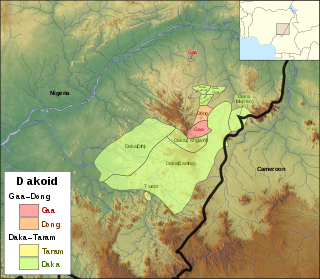Related Research Articles
The Adamawa languages are a putative family of 80–90 languages scattered across the Adamawa Plateau in central Africa, in Nigeria, Cameroon, Central African Republic, and Chad, spoken altogether by only one and a half million people. Joseph Greenberg classified them as one branch of the Adamawa–Ubangi family of Niger–Congo languages. They are among the least studied languages in Africa, and include many endangered languages; by far the largest is Mumuye, with 400,000 speakers. A couple of unclassified languages—notably Laal and Jalaa—are found along the fringes of the Adamawa area.

There are over 525 native languages spoken in Nigeria. The official language of Nigeria is English, the language of former colonial British Nigeria. As reported in 2003, Nigerian English and Nigerian Pidgin were spoken as a second language by 100 million people in Nigeria. Communication in the English language is much more popular in the country's urban communities than it is in the rural areas, due to globalization.
Ga is an Afro-Asiatic language spoken by about 500,000 people in the Gombi Local Government Area in Adamawa state of Nigeria. Many speakers live across the length and breath of Nigeria. It has three dialects, Ga'anda, Gabun and Boga; Blench (2006) classifies Gabun is a separate language. Its speakers are generally not monolingual in Ga'anda, instead, they use Hausa, Lala, Hona, Kilba, Fulfulde, and Bura. Ga'anda has a rich cultural heritage, its natives are very hospitable people. 70% of its population are Christians, 20% Muslims and 10% Traditionalists.
The Savannas languages, also known as Gur–Adamawa or Adamawa–Gur, is a branch of the Niger–Congo languages that includes Greenberg's Gur and Adamawa–Ubangui families.

Bata (Gbwata) is an Afro-Asiatic language spoken in Nigeria in Adamawa State in the Numan, Song, Fufore and Mubi LGAs, and in Cameroon in North Province along the border with Nigeria. Dialects are Demsa, Garoua, Jirai, Kobotachi, Malabu, Ndeewe, Ribaw, Wadi, and Zumu (Jimo). It is often considered the same language as Bacama.
Fali, or Fali of Mubi after the local city, is a Chadic dialect cluster spoken in Nigeria, in Adamawa State in the Mubi North and Michika LGAs. It is one of several languages in the area that go by the generic name Fali.
The Bambukica.k.a.Trans-Benue or Yungur–Jen languages form a proposed branch of the provisional Savanna languages, a reduced form of the Waja–Jen branch of the old Adamawa languages family. They are spoken in north eastern Nigeria. Their unity is not accepted by Güldemann (2018).
Longuda (Nʋngʋra) is a Niger–Congo language of Nigeria. Joseph Greenberg counted it as a distinct branch, G10, of his Adamawa family. Boyd (1989) assigned it a branch within Waja–Jen. When Blench (2008) broke up Adamawa, Longuda was made a branch of the Bambukic languages.
The Tula–Waja, or Tula–Wiyaa languages are a branch of the provisional Savanna languages, closest to Kam (Nyingwom), spoken in northeastern Nigeria. They are spoken primarily in southeastern Gombe State and other neighbouring states.
The Leko languages are a small group of languages spoken in northern Cameroon and eastern Nigeria. They were labeled "G2" in Joseph Greenberg's Adamawa language-family proposal. The Duru languages are frequently classified with the Leko languages, although their relationship remains to be demonstrated.
The Mumuye languages are a group of Adamawa languages spoken in Taraba State, eastern Nigeria.
The Yendang or Maya languages are a group of Adamawa languages spoken in Adamawa State, eastern Nigeria.
The Duru languages are a group of Savanna languages spoken in northern Cameroon and eastern Nigeria. They were labeled "G4" in Joseph Greenberg's Adamawa language-family proposal.

The Dakoid languages are a branch of the Northern Bantoid languages spoken in Taraba and Adamawa states of eastern Nigeria.
Kwah (Kwa), also known as Baa (Bàː), is a Niger–Congo language of uncertain affiliation; the more it has been studied, the more divergent it appears. Joseph Greenberg counted it as one of the Bambukic languages of the Adamawa family. Boyd (1989) assigned it its own branch within Waja–Jen. Kleinewillinghöfer (1996) removed it from Waja–Jen as an independent branch of Adamawa. When Blench (2008) broke up Adamawa, Kwah became a provisional independent branch of his larger Savannas family.
Daka is one of two languages spoken by the Chamba people in Nigeria, the other being Chamba Leko.
Tula is one of the Savanna languages of Gombe State, northeastern Nigeria.
Lala-Roba is an Adamawa language of Nigeria. Its name is a compound of two of its dialects, Lala (Lalla), Roba (Robba), and Ebode.
The Bena–Mboi (Ɓəna–Mboi) a.k.a.Yungur languages form a branch of the Adamawa family. They are spoken in central Adamawa State, eastern Nigeria, just to the east of Lafia LGA.
The Bikwin–Jen or simply the Jen languages form a branch of the Adamawa family. They are spoken in and around Karim Lamido LGA in Taraba State, and in other nearby states of eastern Nigeria.
References
- ↑ Mboi at Ethnologue (18th ed., 2015)
- ↑ Blench, Roger (2019). An Atlas of Nigerian Languages (4th ed.). Cambridge: Kay Williamson Educational Foundation.
- Roger Blench, 2004. List of Adamawa languages (ms)